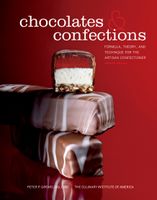Advertisement
Lauric Fats
Appears in
By Peter Greweling and Culinary Institute of America
Published 2007
Lauric fats are occasionally used by the artisan confectioner, primarily for the powerful eutectic effect they have when combined with cocoa butter. (See Eutectics.) Examples of lauric fats are coconut fat and palm kernel oil; of the two, coconut fat is more commonly used by the artisan confectioner. When it is combined with cocoa butter, the resulting eutectic often has a melting point that is lower than either of the original fats, resulting in a meltaway center.
At room temperature coconut fat is a relatively hard fat, one that may be fractionated and/or hydrogenated to provide specific desired melting points. RBD (refined, bleached, deodorized) coconut fat that is not hydrogenated has a melting point of 25°C (76°F), is widely available, and is well suited to the formula applications in this book. Deodorized coconut fat should be used to avoid contributing undesired coconut flavor to confections. In certain applications, such as taffy and nougat, coconut fat may be a lower-cost alternative to cocoa butter and can contribute to the shorter, less chewy texture desired in these confections. When deciding whether to use lauric fat, the confectioner must take into account flavor, texture, and reactions with other ingredients like cocoa butter.



